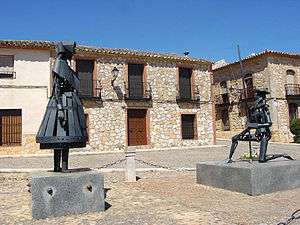Dulcinea del Toboso
| Dulcinea del Toboso | |
|---|---|
| Don Quixote character | |
_09.jpg) Dulcinea (1957), sculpture by F. Coullaut-Valera, in Madrid (Spain). | |
| Created by | Miguel de Cervantes |
| Information | |
| Gender | Female |
| Religion | Roman Catholic |
| Nationality | Spanish |
Dulcinea del Toboso is a fictional character who is unseen in Miguel de Cervantes' novel Don Quixote. Don Quixote describes her appearance in the following terms: "... her name is Dulcinea, her country El Toboso, a village of La Mancha, her rank must be at least that of a princess, since she is my queen and lady, and her beauty superhuman, since all the impossible and fanciful attributes of beauty which the poets apply to their ladies are verified in her; for her hairs are gold, her forehead Elysian fields, her eyebrows rainbows, her eyes suns, her cheeks roses, her lips coral, her teeth pearls, her neck alabaster, her bosom marble, her hands ivory, her fairness snow, and what modesty conceals from sight such, I think and imagine, as rational reflection can only extol, not compare."[1]
She is identified as Aldonza Lorenzo in some parts of the novel, and although she never came to see Don Quixote on his deathbed in the novel, some adaptations, like in Man of La Mancha suggest that Aldonza decides to change her name to Dulcinea to honor Don Quixote after his death when she does visit him because she believes in him. Also, in some adaptions, Aldonza's occupation varies; she has been portrayed as an innkeeper's daughter or a prostitute, instead of a farm girl.

In the Spanish of the time, Dulcinea means something akin to an overly elegant "sweetness". In this way, Dulcinea is an entirely fictional person for whom Quixote relentlessly fights. To this day, a reference to someone as one's "Dulcinea" implies hopeless devotion and love for her, and particularly unrequited love.
The Jules Massenet opera Don Quichotte depicts Dulcinée as a major character, the local queen who sends the knight on a quest to retrieve her jewels.
Another theory is that Dulcinea's name originates from the Dolcinium, Latin name of Ulcinj City on Montenegro's Adriatic coast. It is believed that Cervantes fell in love with a local girl during his captivity in Dulcinium, which inspired him for the character of Dulcinea.
In popular culture
- "Dulcinea" is the female lead in the TV series The Adventures of Puss in Boots.
- "Dulcinea" is referred to in US TV series Ally McBeal as a song her father sings to her as a child. In the final season 5 in episode 10 Ally defends a man who thinks he can fly, and pursued Ally to be his criminal defense lawyer after seeing her in court and thinking she looks like "Dulcinea".
- Dulcinea is the 2008 album by the band Tremoloco
- Dulcinea appears in the Japanese series Zukkoke Knight - Don De La Mancha. Her real name is Fedora (in the English dub). She is daughter of the bandit king, Poormouth. Her role is to help her bankrupt father by stealing, but she fails almost every time. She fools Don Quixote into helping her. She is voiced by Mami Koyama.
- "Dulcinea" is the title of the first episode of the Syfy television show, The Expanse.[2]
- "Dulcinea" is the name of the third track on the album In the Absence of Truth by Isis.
- Dulcinea is the title of the 1994 album by the American indie band Toad the Wet Sprocket.
- "Dulcinea" is the name of the second track on The Penance and the Patience EP by Australian rock band Closure in Moscow.
References
Notes
- ↑ Cervantes, Miguel. "Chapter XIII". Don Quixote (Volume 1).
- ↑ The Expanse (2015), Episode 1, imdb.com; accessed 1 March 2016.